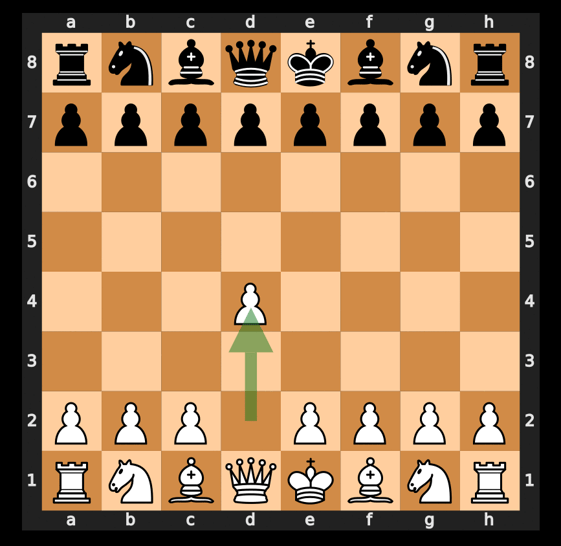Top 30 Variations of d4 Openings in Chess to be at your bestest playing form
CHESS OPENING
12/3/20242 min read


Chess players at the top level have refined the 1.d4 openings into various deep and rich variations. Here are the top 30 most played variations of 1.d4 by the greatest players of all time, grouped by opening systems. These include games from players like Garry Kasparov, Magnus Carlsen, Bobby Fischer, Anatoly Karpov, and others.
1. Queen’s Gambit Declined (QGD)
- Moves: 1.d4 d5 2.c4 e6
- Variations:
1. Classical QGD: 3.Nc3 Nf6 4.Bg5
2. Tartakower Defense: 3.Nc3 Nf6 4.Bg5 Be7 5.e3 h6 6.Bh4 b6
3. Lasker Defense: 3.Nc3 Nf6 4.Bg5 Be7 5.e3 Ne4
4. Exchange Variation: 3.Nc3 Nf6 4.cxd5 exd5
5. Ragozin Defense: 3.Nc3 Nf6 4.Bg5 Bb4
2. Queen's Gambit Accepted (QGA)
- Moves: 1.d4 d5 2.c4 dxc4
- Variations:
6. Main Line: 3.Nf3 Nf6 4.e3 e6 5.Bxc4
7. Central Variation: 3.e4 b5
8. Classical Variation: 3.Nf3 e6 4.e3 a6
9. Alekhine Variation: 3.Nf3 Nf6 4.e3 Bg4
3. Slav Defense
- Moves: 1.d4 d5 2.c4 c6
- Variations:
10. Exchange Variation: 3.cxd5 cxd5
11. Chebanenko Slav (a6 Slav): 3.Nf3 Nf6 4.a6
12. Meran Variation: 3.Nf3 Nf6 4.e3 e6 5.Nc3 Nbd7 6.Bd3 dxc4
13. Semi-Slav Defense: 3.Nf3 Nf6 4.e3 e6
14. Anti-Meran (Botvinnik System): 3.Nf3 Nf6 4.e3 e6 5.Nc3 Nbd7 6.Bg5
4. King's Indian Defense (KID)
- Moves: 1.d4 Nf6 2.c4 g6 3.Nc3 Bg7
- Variations:
15. Classical Variation: 4.e4 d6 5.Nf3 O-O 6.Be2 e5
16. Fianchetto Variation: 4.Nf3 O-O 5.g3 d6 6.Bg2
17. Four Pawns Attack: 4.f4 d6 5.e4 O-O 6.Nf3
18. Saemisch Variation: 4.e4 d6 5.f3
19. Makagonov Variation: 4.Nf3 O-O 5.h3
5. Nimzo-Indian Defense
- Moves: 1.d4 Nf6 2.c4 e6 3.Nc3 Bb4
- Variations:
20. Rubinstein System: 4.e3
21. Classical (Capablanca) System: 4.Qc2
22. Fischer Variation: 4.Nf3
23. Saemisch Variation: 4.a3
24. Leningrad Variation: 4.Bg5
6. Grünfeld Defense
- Moves: 1.d4 Nf6 2.c4 g6 3.Nc3 d5
- Variations:
25. Exchange Variation: 4.cxd5 Nxd5 5.e4 Nxc3 6.bxc3
26. Russian System: 4.Nf3 Bg7 5.Qb3
27. Fianchetto Variation: 4.Nf3 Bg7 5.g3
7. Catalan Opening
- Moves: 1.d4 Nf6 2.c4 e6 3.g3
- Variations:
28. Open Catalan: 4.g3 dxc4
29. Closed Catalan: 4.g3 Be7 5.Bg2 O-O 6.Nf3
8. Dutch Defense
- Moves: 1.d4 f5
- Variations:
30. Leningrad Variation: 2.g3 g6 3.Bg2 Bg7
Middle Game Objectives After 1.d4
1. Control the Center: Many 1.d4 openings aim to establish central dominance with pawns on d4 and e4.
2. Piece Activity: Maximising the scope of bishops and rooks is critical in d4 systems, often involving pawn breaks like c4 or e4.
3. Pawn Breaks: Use pawn breaks such as c5, e5, or f4 to open lines for attacking the king or exploiting weaknesses.
4. King Safety: Ensure a safe king, as most 1.d4 systems lead to slower but solid attacking chances.
5. Space and Flexibility: White typically gains a slight space advantage, which can be leveraged for a kingside or queenside attack.
These variations and objectives show why 1.d4 is a cornerstone of professional chess.
